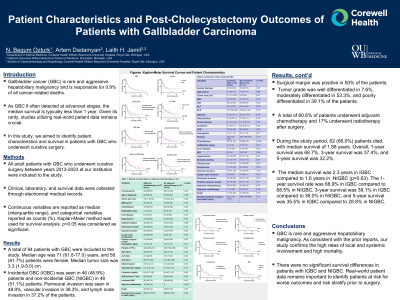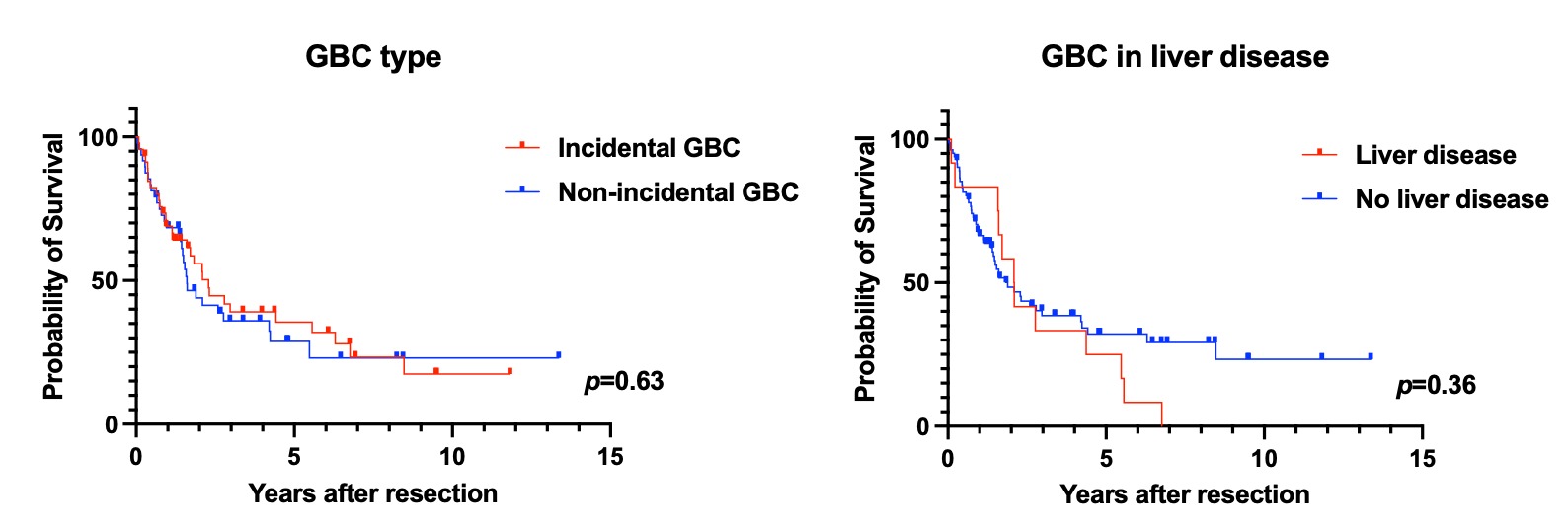Sunday Poster Session
Category: Biliary/Pancreas
P0009 - A Cross-Sectional Study of Patient Characteristics and Survival in Patients With Resectable Gallbladder Carcinoma
Sunday, October 27, 2024
3:30 PM - 7:00 PM ET
Location: Exhibit Hall E

Has Audio
- NO
Nazli Begum Ozturk, MD
Corewell Health William Beaumont University Hospital
Royal Oak, MI
Presenting Author(s)
Nazli Begum Ozturk, MD1, Artem Dadamyan, MS2, Laith H. Jamil, MD2
1Corewell Health William Beaumont University Hospital, Royal Oak, MI; 2Oakland University William Beaumont School of Medicine, Royal Oak, MI
Introduction: Gallbladder cancer (GBC) is a rare hepatobiliary malignancy. As GBC if often detected at advanced stages, the median survival is typically less than 1 year. Given its rarity, studies utilizing real-world patient data remains crucial. In this study, we aimed to identify patient characteristics and outcomes in patients with GBC who underwent curative surgery.
Methods: All adult patients with GBC who had curative resection between years 2013-2023 at our institution were included. Demographic, clinical, treatment, and survival data were collected. Continuous variables are reported as median (interquartile range), and categorical variables reported as counts (%). Kaplan-Meier curves were used for survival analysis. p< 0.05 was considered as significant.
Results: A total of 94 patients were included to the study. Median age was 71 (61.8-77.0) years, and 58 (61.7%) patients were female. Median tumor size was 3.3 (1.9-5.0) cm. Incidental GBC (IGBC) was seen in 46 (48.9%) patients and non-incidental GBC (NIGBC) in 48 (51.1%) patients. Of all patients, 12.8% had concomitant liver disease, and the age at diagnosis was significantly lower in patients with liver disease compared to without [61 (56-69) vs 72 (64-79), p=0.003], respectively. Perineural invasion was seen in 48.9%, vascular invasion in 38.3%, and lymph node invasion in 37.2% of the patients. Positive surgical margin was present in 50% of the patients. A total of 60.6% of patients had adjuvant chemotherapy and 17% had radiotherapy. During the study period, 62 (66.0%) patients died, with a median survival of 1.9 years. Overall, 1-year survival was 68.7%, 3-year survival was 37.4%, and 5-year survival was 32.2%. Cholelithiasis was significantly more common in patients with IGBC (91.3%) compared to NIGBC (66.7%), p=0.002, and the lymph node invasion was significantly more common in patients with IGBC (50%) compared to NIGBC (25%), p=0.02. The median survival was 2.3 years in IGBC, compared to 1.6 years in NIGBC (p=0.63). The 1-year survival rate was 68.9% in IGBC compared to 68.5% in NIGBC, 3-year survival was 39.1% in IGBC compared to 36.0% in NIGBC, and 5-year survival was 35.5% in IGBC compared to 28.8% in NIGBC.
Discussion: GBC is aggressive, and consistent with the prior reports, our study confirms the high rates of local and systemic involvement and high mortality. IGBC and NIGBC did not have significantly different survival difference. Real-world patient data remains important to identify patients at risk for worse outcomes.

Disclosures:
Nazli Begum Ozturk, MD1, Artem Dadamyan, MS2, Laith H. Jamil, MD2. P0009 - A Cross-Sectional Study of Patient Characteristics and Survival in Patients With Resectable Gallbladder Carcinoma, ACG 2024 Annual Scientific Meeting Abstracts. Philadelphia, PA: American College of Gastroenterology.
1Corewell Health William Beaumont University Hospital, Royal Oak, MI; 2Oakland University William Beaumont School of Medicine, Royal Oak, MI
Introduction: Gallbladder cancer (GBC) is a rare hepatobiliary malignancy. As GBC if often detected at advanced stages, the median survival is typically less than 1 year. Given its rarity, studies utilizing real-world patient data remains crucial. In this study, we aimed to identify patient characteristics and outcomes in patients with GBC who underwent curative surgery.
Methods: All adult patients with GBC who had curative resection between years 2013-2023 at our institution were included. Demographic, clinical, treatment, and survival data were collected. Continuous variables are reported as median (interquartile range), and categorical variables reported as counts (%). Kaplan-Meier curves were used for survival analysis. p< 0.05 was considered as significant.
Results: A total of 94 patients were included to the study. Median age was 71 (61.8-77.0) years, and 58 (61.7%) patients were female. Median tumor size was 3.3 (1.9-5.0) cm. Incidental GBC (IGBC) was seen in 46 (48.9%) patients and non-incidental GBC (NIGBC) in 48 (51.1%) patients. Of all patients, 12.8% had concomitant liver disease, and the age at diagnosis was significantly lower in patients with liver disease compared to without [61 (56-69) vs 72 (64-79), p=0.003], respectively. Perineural invasion was seen in 48.9%, vascular invasion in 38.3%, and lymph node invasion in 37.2% of the patients. Positive surgical margin was present in 50% of the patients. A total of 60.6% of patients had adjuvant chemotherapy and 17% had radiotherapy. During the study period, 62 (66.0%) patients died, with a median survival of 1.9 years. Overall, 1-year survival was 68.7%, 3-year survival was 37.4%, and 5-year survival was 32.2%. Cholelithiasis was significantly more common in patients with IGBC (91.3%) compared to NIGBC (66.7%), p=0.002, and the lymph node invasion was significantly more common in patients with IGBC (50%) compared to NIGBC (25%), p=0.02. The median survival was 2.3 years in IGBC, compared to 1.6 years in NIGBC (p=0.63). The 1-year survival rate was 68.9% in IGBC compared to 68.5% in NIGBC, 3-year survival was 39.1% in IGBC compared to 36.0% in NIGBC, and 5-year survival was 35.5% in IGBC compared to 28.8% in NIGBC.
Discussion: GBC is aggressive, and consistent with the prior reports, our study confirms the high rates of local and systemic involvement and high mortality. IGBC and NIGBC did not have significantly different survival difference. Real-world patient data remains important to identify patients at risk for worse outcomes.

Figure: Survival curves for patients with incidental and non-incidental gallbladder carcinoma, and patients with liver disease.
Disclosures:
Nazli Begum Ozturk indicated no relevant financial relationships.
Artem Dadamyan indicated no relevant financial relationships.
Laith Jamil indicated no relevant financial relationships.
Nazli Begum Ozturk, MD1, Artem Dadamyan, MS2, Laith H. Jamil, MD2. P0009 - A Cross-Sectional Study of Patient Characteristics and Survival in Patients With Resectable Gallbladder Carcinoma, ACG 2024 Annual Scientific Meeting Abstracts. Philadelphia, PA: American College of Gastroenterology.
